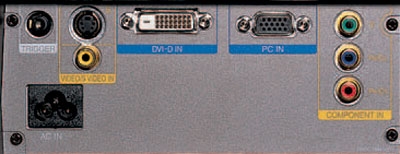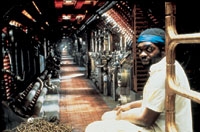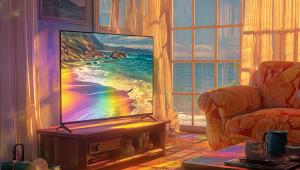Panasonic PT-AE500U LCD HDTV Projector Page 2
A manual zoom lens allows some positioning flexibility relative to the screen, and digital keystone correction lets you place the projector a little off center. Avoid using keystone, however, since it reduces video resolution. There are two lamp-power positions. Low reduces fan noise, extends lamp life, and generally delivers a blacker black, while High makes the image brighter. Naturally I chose Low for testing. Panasonic claims a lamp life of about 2,000 hours in normal use. 
Although the user menu looks like a screen shot from a circa-1982 Timex Sinclair, it includes a thoroughly modern collection of picture adjustments. You can set contrast, brightness, and most other controls independently for each input, so switching inputs will automatically switch the settings (DVI offers all the picture adjustments except tint and color). In addition, a trio of other memories can be stored in user-accessible slots, so you can even save separate picture adjustments for the same input.
Setting up the AE500U was a breeze. I chose a 16:9 ratio, 96-inch diagonal (48 1/4 x 83 1/4-inch) Stewart Grayhawk screen, designed to increase the apparent contrast of DLP and LCD projectors. The AE500U's close pixel spacing and high resolution let me sit 13 feet away from the big screen and still not see any pixel structure in the image. But when I moved up to 11 feet, pixels did start to become visible along the edges of text. Of course, you'll be able to sit closer if you use a smaller screen.
 |
| The PT-AE500U projector revealed the subtle details of Alien's dark scenes, but its black was a very dark gray. |
I'll get this out of the way right now: like every other non-CRT projector I've seen, the AE500U can't display a deep, inky black, which was obvious when I popped in the new Director's Cut DVD of the 1979 sci-fi/horror masterpiece Alien. In one scene, for example, the crashed, horseshoe-shaped alien vessel looms out of the darkness as three crewmembers approach. The more shadowy areas of the ship blended into the letterbox bar above the picture, but neither were truly black - just a very dark gray. But this projector's black is as dark as on any LCD I've seen, though still not on par with the best DLP projectors.
As a TV reviewer, I'm fairly attuned to these black-level issues, but I still found myself forgetting them at times during Alien - surely one of the darkest (in every sense of the word) movies ever made. Thanks to the AE500U's excellent handling of dim scenes, I could see plenty of detail in the sides of the ship as the space-suited explorers climbed closer. The shadows faded naturally into light or darkness, without the jarring gradations I've seen on other displays. Sudden intrusions of bright light, like the alarm spotlight that activates when the explorers' ship lands too hard, were likewise rendered naturally.
| PLUS Reasonably priced. Excellent video processing. Good shadow detail. MINUS Can't reproduce deep blacks. |
As I expected, the HDTV-capable AE500U had no problems conveying the remarkable detail of this crystal-clean DVD. When the explorers walked along the interior hallways, the disturbingly throatlike walls glistened with mucus, and as the astronauts emerged onto the alien ship's bridge, the dirty organic pipes and surfaces crawled with black grime. The projector's video processing was equally impressive. I saw nothing but stable lines and fine details in the zoom-out pan that reveals the full view of the giant flight seat and its dessicated alien occupant.
For HDTV viewing I turned to Russian Ark, recorded in 1080i by the Dish DVR 921 from the HDNet Movies channel. This film, shot entirely in digital high-definition video in the Hermitage Museum in St. Petersburg, Russia, and comprising a single 90-minute take, is a visual feast that the AE500U served up with oodles of detail. In one scene, the black-costumed guide wanders into a spacious room lined to the ceiling with paintings, and I could study them individually even though they weren't the focus of the shot. Once again, my only complaint was the less-than-black blacks.
Black-level issues aside, Panasonic's PT-AE500U is a projection powerhouse. If you're outfitting a modest home theater and want to watch HDTV, its price-to-performance ratio alone makes it worth the audition. After all, getting an 8-foot-diagonal high-definition picture in the living room without spending an arm and a leg is a pretty revolutionary concept.
In the Lab
Color temperature (-1 color temperature, Cinema1 setting before/after calibration) Low window (20-IRE) 7,539/6,525 K High window (100-IRE) 7,454/6,598 K
Brightness (Warm2 color temperature, Movie setting before/after calibration, 100-IRE) 6.19/7.35 ftL
Prior to calibration, the PT-AE500U measured close to the NTSC standard of 6,500 K, though it was a little too red. After grayscale calibration, it came within 100 K of the standard. Grayscale tracking was very good both before and after calibration. (Calibration needs to be performed by a qualified technician with specialized equipment, so discuss it with your dealer before purchase, or call the Imaging Science Foundation at 561-997-9073.)
The color-decoder patterns from the Avia and Digital Video Essentials test DVDs confirmed that the 500U's decoder de-accentuated green. Avia indicated an error of about -15%. Red was fine, however. The projector did an excellent job of recognizing the 2:3 pulldown cadence of interlaced video programs. Engaging horizontal or vertical keystone correction reduced resolution in the Multiburst patterns from Digital Video Essentials. Geometry and corner-to-corner focus were perfect, and white field uniformity was very good. No screen-door effect was visible. - D.K.














































